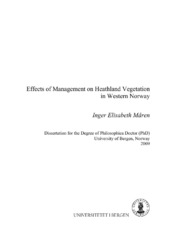Effects of Management on Heathland Vegetation in Western Norway
Doctoral thesis
Permanent lenke
http://hdl.handle.net/1956/3282Utgivelsesdato
2009-03-31Metadata
Vis full innførselSamlinger
Sammendrag
Aims: This synthesis of studies examines the effects of anthropogenic disturbance regimes; the traditional management practices of livestock grazing and prescribed burning, on vegetation and seed banks in coastal heathlands of Western Norway. Effects of germination cues on the key species Calluna vulgaris are also discussed. Threats and conservation aspects in relation to different mechanical and chemical bracken control measures are investigated. The concept of heathland conservation is integrated into a wider frame-work, discussing biodiversity, ecosystem services and the global context. Methods: I combine long-term (> 10 years) experiments and chronosequence data (0-30 years) with germination trials on seed banks and seeds to investigate patterns and processes of heathland vegetation, seed bank dynamics, role of seed bank, effects of fire-related germination cues on Calluna vulgaris, and the effects of bracken control measures in response to the land-use practices of grazing and burning. The project is based on field data, seed bank samples and seed samples collected at Lygra, North Hordaland, western Norway. The greenhouse seedling emergence trials were carried out at the Norwegian Arboretum at Milde, Bergen, while the seed germination experiments were performed at Wakehurst Place, Royal Botanic Gardens Kew, UK. Major results: (i) Fire induced strong successional trends in the species composition, while grazing added complexity to the post-fire successional dynamics, increased variability among habitats, and created ecological opportunities for additional species. (ii) Vegetation species richness showed a unimodal pattern over the post-fire succession, while the seed bank species richness showed no trend, suggesting that the seed bank acts as a refuge, providing a constant source of recruits for species to colonize newly-burnt areas. Fire also produces germination cues such as ash and smoke, enhancing seed germination in the key species Calluna vulgaris. (iii) Bracken control by means of cutting twice yearly is nearly as effective as spraying with the herbicide asulam combined with yearly follow-up cutting. Conclusions: Traditional management regimes do not have simple additive effects within the heathland system but interact to create heterogeneity. The traditional management has not depleted or destroyed the seed banks; indeed, continued management is needed to ensure the sustainability of northern heathlands. Implications for conservation: Sustainable management strategies are needed to preserve diversity and heathland conservation should aim to replicate the complexity that traditional management regimes create, both in terms of the actual disturbances as well as the spatial scales at which they are applied. Organic farming and nature conservation may call for alternative approaches to herbicide application for bracken control; results presented here show this to be feasible. Open landscapes such as heathlands are of importance for people's well-being through their recreational and therapeutic values as ecosystem services. Consequently, they should be managed in a sustainable manner for the future.
Består av
Paper I: Måren, I. E. & Vandvik, V., Fire and regeneration: The role of seed banks in the dynamics of northern heathlands. Accepted for publication in Journal of Vegetation Science. Published by Wiley-Blackwell. Full-text not available.Paper II: Måren, I. E.; Janovský, Z.; Spindelböck, J. P.; Daws, M. I.; Kaland, P. E. & Vandvik, V., Prescribed burning of northern heathlands: Calluna vulgaris and germination. Submitted to Plant Ecology. Published by Springer. Full-text not available.
Paper III: Journal of Applied Ecology 42, Vandvik, V.; Heegaard E.; Måren, I. E. & Aarrestad, P.A., Managing heterogeneity: the importance of grazing and environmental variation on post-fire succession in heathlands, pp. 139-149. Copyright 2005 British Ecological Society. Published by Wiley-Blackwell. Full-text not available due to publisher restrictions. Published version available here: http://dx.doi.org/10.1111/j.1365-2664.2005.00982.x
Paper IV: Biological Conservation 141, Måren, I. E.; Vandvik, V. & Ekelund, K., Restoration of Bracken-invaded Calluna vulgaris heathlands: Effects on vegetation dynamics and non-target species., pp. 1034-1044. Copyright 2008 Elsevier. Full-text not available due to publisher restrictions. Published version available here: http://dx.doi.org/10.1016/j.biocon.2008.01.012
Paper V: Conservation Evidence 5, Måren, I. E.; Vandvik, V. & Ekelund, K., Effectiveness of chemical and mechanical bracken Pteridium aquilinum control treatments in northern coastal heathlands on the island of Lygra, Hordaland, Norway, pp. 12-17. Published by the University of Cambridge. Full-text not available.
